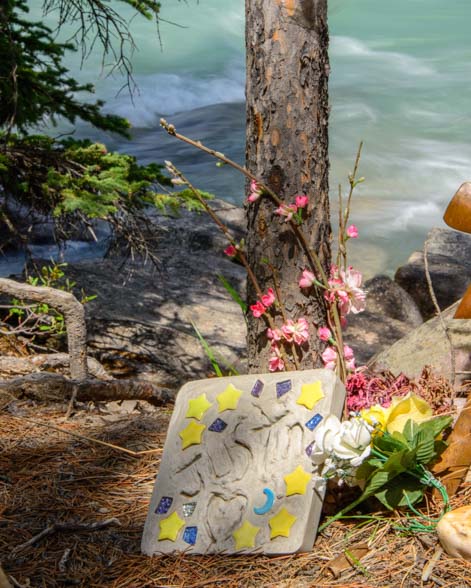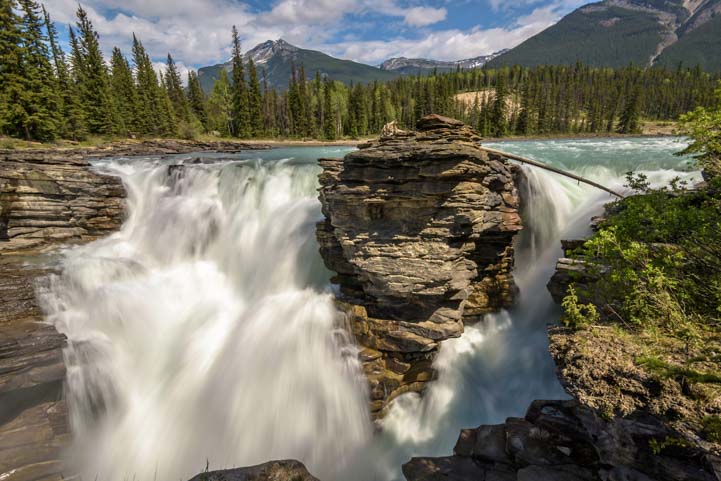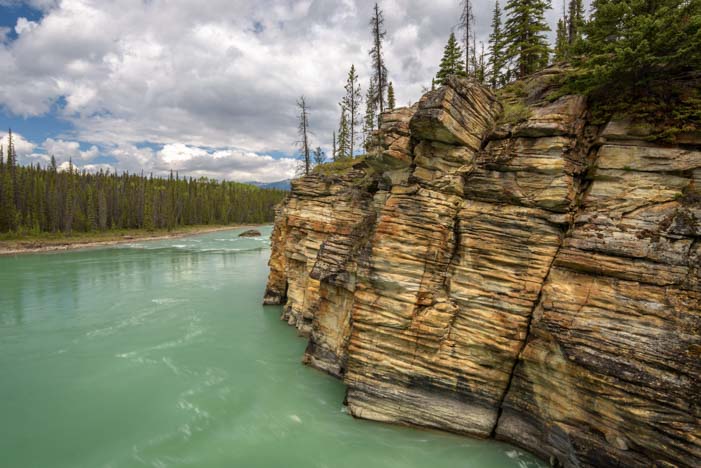May 2016 – During our RV travels through the Canadian Rockies, we explored the southern half of the Icefields Parkway a lot because it was easily accessible from our camping spot in Lake Louise. The beauty of the scenery on the Parkway astonished us every time.

The Icefields Parkway was stunning every time we drove it.
But at last we struck out and drove the whole thing up to the town of Jasper.

What a great scenic drive!
The Icefields Parkway is about 150 miles long, and every turn opened up another spectacular view.

We never got tired of driving the Icefields Parkway!
The funny thing in this part of the Canadian Rockies is that two of the National Parks, Yoho and Kootenay, are in the province of British Columbia while the other two, Banff and Jasper, are in the province of Alberta. They all abut each other, but they are on the eastern and western borders of those two provinces.
The southern half of the Icefields Parkway is in Banff National Park, and eventually we came to the northern border of that park and crossed into Jasper National Park. The snow made fantastic patterns on the mountains.

Entering Jasper National Park, the snow created beautiful patterns on the mountains.

.
The main attraction in the central portion of the Icefields Parkway, in Jasper National Park, is the Columbia Icefields. As we approached, we could see thick blankets of snow on the mountain peaks.

The snow was really deep near the tops of some of the mountains.
In places the snow was piled extremely high and was sheered off in a vertical wall as if it had been plowed. But those vertical walls of snow had to be a few hundred feet high! Some of the ice in these snow piles was turquoise.

Talk about a thick blanket of snow!
There was lots of avalanche activity in the mountain tops, and in some places ice and snow tumbled down.

Avalanche!
When we stopped and got out of the truck, we could hear the thunderous rumble of avalanches way up high.

.
The Columbia Icefields is an area of true glaciers — enormous bodies of ice that flow across the land, crushing the earth beneath them into a fine powder, and staying frozen year round.
There is a massive visitors center at the Columbia Icefields, and folks went up on the deck to take in the view and get photos.

Glaciers and avalanches make a great backdrop for a photo!
Down in the parking lot, dozens of tour buses were lined up waiting to take people out to the glaciers. This wasn’t quite what we expected.

Tour buses line up at the visitors center to take tourists out to the Columbia Icefields.
There were snowcat excursions that took people out onto the glaciers to drive around and walk around on the ice.

The Snowcats drive out onto the glacier.
We must have arrived just after a bunch of tour buses got there because there were throngs of people walking between the visitors center and the parking lot. Inside the visitors center there was an almost impenetrable crowd of people watching several big screen TVs that were showing videos of what you’d experience on the glacier excursions. To one side there was a very long line of people buying tickets.
This place is incredibly popular! And very few people were speaking English with a North American accent of any kind!!
Outside, we watched the tour buses disappear into the distance on the road that led out to the icefields.

Three tour buses head out to the Columbia Icefields from the visitors center.
We had been enjoying a more solitary experience as we had driven the parkway that morning, soaking in the views without a narrator or crowd of companions, and we weren’t in a full-on tourism kind of mood. So we opted to save a glacier excursion for another visit.
One thing that intrigued us about the Icefields Parkway is that the highest part of the entire road and the highest mountain peaks are all in the southern end in the Banff National Park half, and they aren’t all that high.
Even though the Parkway offers the most spectacular mountain scenery we have seen in North America, the Bow Lake summit in the southern half of the Parkway, which is the highest summit of any paved road in Canada, is just 6,800 feet above sea level, while the village of Lake Louise sits at just 5,249 feet. Both of these are lower than Flagstaff, Arizona, which is around 7,000 feet!
Surprisingly, the Red Mountain Pass outside of Ouray, Colorado, traverses a summit of 11,000 feet, and the rim overlooks at Cedar Breaks National Park amphitheater in Utah are at 10,000 feet. But nowhere have we seen jagged peaks and towering mountains like those around Banff.
As we drove north towards Jasper, our elevation gradually dropped to just 3,500 feet, and the snow began to disappear from the mountains.

As we approached Jasper, the mountains lost their snow.
They towered over us in glorious splendor, but there were none of the snowcapped peaks we had been living with for the last few weeks!

The Jasper National Park portion of the Icefields Parkway.
We stopped to photograph a wonderful waterfall that was right next to the parkway.

A waterfall by the side of the road caught our eye.
And then we arrived at Athabasca Falls, a place with such a great name we just had to check it out!
Athabasca Falls has lots of wonderful short trails that wander all around the river and falls, offering a wide variety of views, and some fabulous winding stairs weave between the rock walls. Everyone stopped at the top of these stairs on their way down to get a photo. We did too!

Curvy stairs and rocks… so cool!
Once we got down below the falls, we had a fantastic view looking back up at them and the bridge that crosses over them. A rain shower had just passed through, and all the vegetation and moss was glowing.

Lush vegetation surrounds Athabasca Falls.
The waterfall itself is not very tall or long but the water crashes down with great force through a picturesque canyon.

Athabasca Falls.
The sound of the water slipping over the edge from the serene river upstream is very loud, and the power of the rushing water is extraordinary. I suspect the copious recent rains and spring run-off added to the water flow and made it especially impressive.

You could hear the sound of Athabasca Falls from quite a distance away.
I wandered down a pretty wooded trail on the far side of the waterfall and found myself a little upstream of the thundering falls where the river was much more placid. It flowed quickly but not at a sprinter’s pace.
The trail went right along the water’s edge. Suddenly I saw a warning sign and some caution tape strung between two trees. Underneath there was a lovingly made ceramic plaque that had a heart and stars and moons on it and the name Justin in big letters.

.
On the other side of the trail I saw another sign that memorialized a young man named Justin who, at 24 years of age in 2012, ventured a little too close to the edge and was swept away over the falls.
I looked at the rapidly flowing water just behind the plaque and the inviting way the light was playing around the tree trunks at the water’s edge. I felt that curious and familiar lure to reach down and dip my hand in the swirling water.
Chills went up my spine.
I wandered back to the heart of the falls and suddenly saw them with a new and very cautious eye.

The power of these falls was a little unnerving after seeing the family memorial for Justin.
The force of that water was staggering!

Yikes!
Books have been written about the dramatic ways people die in the National Parks, but this tiny, tearful yet smiling memorial on the edge of a little used trail told a much more vivid story than the words in any book ever could.
I gathered myself together and wandered around until I found Mark at a gorgeous viewpoint overlooking the narrow canyon. He snagged a beautiful shot.

Dawn at Athabasca Falls
We returned to Athabasca Falls at dawn one morning to catch the soft light filtering through the mist as it hovered above the water.

Sunrise and mist at daybreak.
The peacefulness of the falls at that early hour was magical.

.
As always, 24/7, the thunderous roar of the water filled the air everywhere, giving the place an incredibly noisy soundtrack. But besides us and a ranger and another pair of early risers, the woods were utterly still.

Sunrise paints the sky and water in pastel colors.
Below the falls the water was flat and playfully swirled around in big sweeping eddies as it made its way downstream.

.
Later in the day, the water in that spot turned a milky shade of jade. The horizontally striped yellow and orange rock cliffs on the far side of the river made a striking contrast to the water.

As the sun rose, the Athabasca River became jade green.
There is a rocky beach of sorts at this spot below the falls, and we wandered around on the rocks for a bit. Someone — or a group of someones — had built fifty or more rock cairns in the shape of little people all over the beach.
It was an intriguing sight that must have a very cool story behind it, but there were no other clues about its meaning or origins… just a thick collection of little rock people standing around, facing in all directions, arms out.
[Note: Several readers contacted us after reading this post to let us know these cairns are “Inuksuks” (there are various spellings) that have their origins with the indigenous people of the far north.]

Someone had made 50 or so rock cairns by the water’s edge. Many looked like people!
We learned after publishing this post that these are “Inuksuks.”
When we got back to the parking lot there was a group of people standing around there too, but these folks were all aiming their cameras at our trailer! As we got closer, we realized why. Someone had parked a tiny teardrop trailer right next to our buggy, and the two looked very cute together.

Are these trailers the same species??
The people with the cameras were all from Europe, and the idea of lugging around a trailer as huge as ours struck them as a funny and quirky oddity that’s appropriately peculiar to the New World where large roads and long distances are common.
As we chatted about RVs on both sides of the pond, and showed them the inside of our rig, they busily uploaded their pics of the big-and-little-brother trailers from their phones to Facebook for friends and family back in Germany and the Czech Republic (which our newfound friends informed us had just acquired the new name of Czechia a few weeks prior).
What a crazy, instantaneous and in-the-moment world this is!!
The folks with the teardrop trailer returned. They hailed from Tennessee and were headed to Alaska on a four month tour. We hopped in our truck and carried on towards the town of Jasper.
As our many posts from the Canadian Rockies have shown, the National Parks at the heart of the most dramatic of the Rocky Mountains are a great area for RV travelers to explore. Scroll down for some links to help you plan your bucket list trip!!
Subscribe
Never miss a post — it’s free!
More info on the Icefields Parkway, Jasper National Park and Athabasca Falls:
- Icefields Parkway Tourism Info
- Jasper National Park – Parks Canada Website
- Athabasca Falls Tourism Info
- Where are these places?
Blog posts from our travels in the Canadian Rockies:
- Waterton Lakes Nat’l Park – Starry Skies, the Milky Way & Wildflowers
- Waterton Shoreline Cruise – A Classy Tour of Waterton-Glacier NP
- Waterton Lakes National Park – Rocky Mountain High!
- Kananaskis Country – Canadian Rockies Beauty Off the Beaten Path
- Canmore, Alberta – An Outdoor Lover’s Town in the Rocky Mountains
- Hot Springs in the Canadian Rockies – Swimming in Giant Hot Tubs!!
- Banff, Alberta – A Grand Resort Town in the Canadian Rockies
- Yoho National Park – Emerald Lake & Natural Bridge – Aqua Magic!
- Moraine Lake – Crown Jewel of Banff National Park
- Icefields Parkway – True Blue Lakes, Avalanches & Grouse!
- Icefields Parkway – Canadian Rockies Scenic Drive – WOW!
- Lake Louise – RV Travels to the Heart of the Rockies in Banff
- Kootenay National Park Canada – Bears, Mountains & Rivers!
- Canadian Rockies – Big Mountains & Bighorn Sheep!
Tips for travelers visiting Canada by RV
All of our RV travels in Canada (East and West)
Love waterfalls? We’ve seen some fabulous falls in our travels:
- Waterfalls of the Blue Ridge Parkway in North Carolina
- Waterfalls of the Blue Ridge Parkway in Virginia
- Agua Azul and Misol-Ha – Beautiful Waterfalls in Mexico
Our most recent posts:
- How to Install Starlink Gen 3 in an RV? Use the Speedmount! 08/07/25
- Escape to Paradise – Rocky Mountain Magic! 08/01/25
- Is Forest River a Good RV? Well Built? Here’s Our Experience 06/20/25
- Sunset Crater Nat’l Monument – Lava & Camels at Bonito CG! 06/06/25
- 2024 Alpha Wolf 17CB Trailer – Our Goldilocks RV! 04/25/25
More of our Latest Posts are in the MENU above.
<-Previous || Next->
